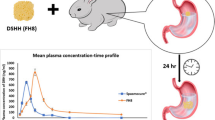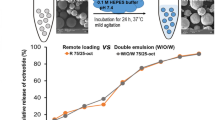Abstract
Purpose. The aim of this study was to investigate the enhancement of peroral octreotide absorption using delivery systems based on superporous hydrogel (SPH) and SPH composite (SPHC) polymers.
Methods. Six female pigs (BW of 23.5 kg) were used in this study. SPH-based delivery systems were made of two components: 1) a conveyor system made of SPH and SPHC; 2) a core that contained octreotide. The core was inserted into the conveyor system (core inside, c.i.) or attached to the surface of the conveyor system (core outside, c.o.). Four different peroral formulations were investigated: c.i., c.o., core outside including trimethyl chitosan chloride (c.o.t.), and octreotide only in the absence of any polymer (o.o.). All formulations were placed in enteric-coated gelatin capsules (size 000) and administered perorally. Intravenous administration was used to determine bioavailability (F) values. Blood samples taken from the cannulated jugular vein were analyzed by radioimmunoassay.
Results. Peroral administration of 15 mg o.o. resulted in low F values of 1.0 ± 0.6% (mean ± SEM) whereas c.i. and c.o. administrations resulted in remarkably higher F values of 12.7 ± 3.6% and 8.7 ± 2.4%, respectively. By the addition of trimethyl chitosan chloride as an extra absorption enhancer to c.o.t., the highest bioavailability (16.1 ± 3.3%) was achieved.
Conclusions. These novel delivery systems based on SPH and SPHC polymers are able to increase the peroral bioavailability of octreotide by mechanical fixation and increasing the retention of the dosage form at the absorption site.
Similar content being viewed by others
REFERENCES
J. A. Fix. Oral controlled release technology for peptides: status and future prospects. Pharm.Res. 13:1760-1764 (1996).
S. B. Zhou, X. M. Deng, and X. H. Li. Investigation on a novel core-coated microspheres proteins delivery system. J.Control.Release 75:27-36 (2001).
D. Ameye, J. Voorspoels, P. Foreman, J. Tsai, P. Richardson, S. Geresh, and J. P. Remon. Trypsin inhibition, calcium and zinc ion binding of starch-g-poly(acrylic acid) copolymers and starch/poly (acrylic acid) mixtures for peroral peptide drug delivery. J.Control.Release 75:357-364 (2001).
P. Langguth, V. Bohner, J. Heizmann, H. P. Merkle, S. Wolffram, G. L. Amidon, and S. Yamashita. The challenge of proteolytic enzymes in intestinal peptide delivery. J.Control.Release 46:39-57 (1997).
C. Damgé, J. Vonderscher, P. Marbach, and M. Pinget. Poly (alkyl cyanoacrylate) nanocapsules as a delivery system in the rat for octreotide, a long-acting somatostatin analogue. J.Pharm.Pharmacol. 49:949-954 (1997).
M. Thanou, J. C. Verhoef, J. H. M. Verheijden, and H. E. Junginger. Intestinal absorption of octreotide using trimethyl chitosan chloride: Studies in pigs. Pharm.Res. 18:823-828 (2001).
L. H. Ottesen, N. K. Aagaard, M. Kiszka-Kanowitz, M. Rehling, J. H. Henriksen, E. B. Pedersen, A. Flyvbjerg, and F. Bendtsen. Effects of a long-acting formulation of octreotide on renal function and renal sodium handling in cirrhotic patients with portal hypertension: A randomized, double-blind, controlled trial. Hepatology 34:471-477 (2001).
R. A. Harrigan, M. S. Nathan, and P. Beattie. Oral agents for the treatment of type 2 diabetes mellitus: pharmacology, toxicity, and treatment. Ann.Emerg.Med. 38:68-78 (2001).
T. Takacs, F. Hajnal, J. Nemeth, J. Lonovics, and A. Pap. Stimulated gastrointestinal hormone release and gallbladder contraction during continuous jejunal feeding in patients with pancreatic pseudocyst is inhibited by octreotide. Int.J.Pancreatol. 28:215-220 (2000).
P. Schiedermaier, B. Goke, and T. Sauerbruch. Effects of different octreotide dosages on splanchnic hemodynamics and glucagon in patients with TIPS. Am.J.Gastroenterol. 96:2218-2224 (2001).
J. Chen and K. Park. Synthesis and characterization of superporous hydrogel composites. J.Control.Release 65:73-82 (2000).
F. A. Dorkoosh, J. Brussee, J. C. Verhoef, G. Borchard, M. Rafiee-Tehrani, and H. E. Junginger. Preparation and NMR characterisation of superporous hydrogels (SPH) and SPH composites. Polymer 41:8213-8220 (2000).
F. A. Dorkoosh, J. C. Verhoef, G. Borchard, M. Rafiee-Tehrani, and H. E. Junginger. Development and characterization of a novel peroral peptide drug delivery system. J.Control.Release 71:307-318 (2001).
M. Thanou, J. C. Verhoef, P. Marbach, and H. E. Junginger. Intestinal absorption of octreotide: N-trimethyl chitosan chloride (TMC) ameliorates the permeability and absorption properties of the somatostatin analogue in vitro and in vivo. J.Pharm.Sci. 89:951-957 (2000).
P. Marbach, M. Neufeld, and J. Pless. Clinical applications of somatostatin analogs. Adv.Exp.Med.Biol. 188:339-353 (1985).
M. Gibaldi and D. Perrier. Pharmacokinetics. In J. Swarbrick (ed.), Drugs and the Pharmaceutical Sciences, Marcel Dekker, New York, 1975 pp. 409-424.
G. A. Digenis, E. P. Sandefer, R. C. Page, W. J. Doll, T. B. Gold, and N. B. Darwazeh. Bioequivalence study of stressed and nonstressed hard gelatin capsules using amoxicillin as a drug marker and gamma scintigraphy to confirm time and GI location of in vivo capsule rupture. Pharm.Res. 17:572-582 (2000).
A. F. Parr, E. P. Sandefer, P. Wissel, M. McCartney, C. McClain, U. Y. Ryo, and G. A. Digenis. Evaluation of the feasibility and use of a prototype remote drug delivery capsule (RDDC) for non-invasive regional drug absorption studies in the GI tract of man and beagle dog. Pharm.Res. 16:266-271 (1999).
F. A. Dorkoosh, G. Borchard, M. Rafiee-Tehrani, J. C. Verhoef, and H. E. Junginger. Evaluation of superporous hydrogel (SPH) and SPH composite in porcine intestine ex-vivo: Assessment of drug transport, morphology effect, and mechanical fixation to intestinal wall. Eur.J.Pharm.Biopharm. 53:161-166 (2002).
F. A. Dorkoosh, D. Setyaningsih, G. Borchard, M. Rafiee-Tehrani, J. C. Verhoef, and H. E. Junginger. Effects of superporous hydrogels on paracellular drug permeability and cytotoxicity studies in Caco-2 cell monolayers. Int.J.Pharm. 241:35-45 (2002).
S. S. Davis. Delivery systems for biopharmaceuticals. J.Pharm.Pharmacol. 44:186-190 (1992).
F. A. Dorkoosh, J. C. Verhoef, M. H. C. Ambagts, M. Rafiee-Tehrani, G. Borchard, and H. E. Junginger. Peroral delivery systems based on superporous hydrogel polymers: Release characteristics for the peptide drugs buserelin, octreotide and insulin. Eur.J.Pharm.Sci. 15:433-439 (2002).
Author information
Authors and Affiliations
Corresponding author
Rights and permissions
About this article
Cite this article
Dorkoosh, F.A., Verhoef, J.C., Verheijden, J.H.M. et al. Peroral Absorption of Octreotide in Pigs Formulated in Delivery Systems on the Basis of Superporous Hydrogel Polymers. Pharm Res 19, 1532–1536 (2002). https://doi.org/10.1023/A:1020416918624
Issue Date:
DOI: https://doi.org/10.1023/A:1020416918624




